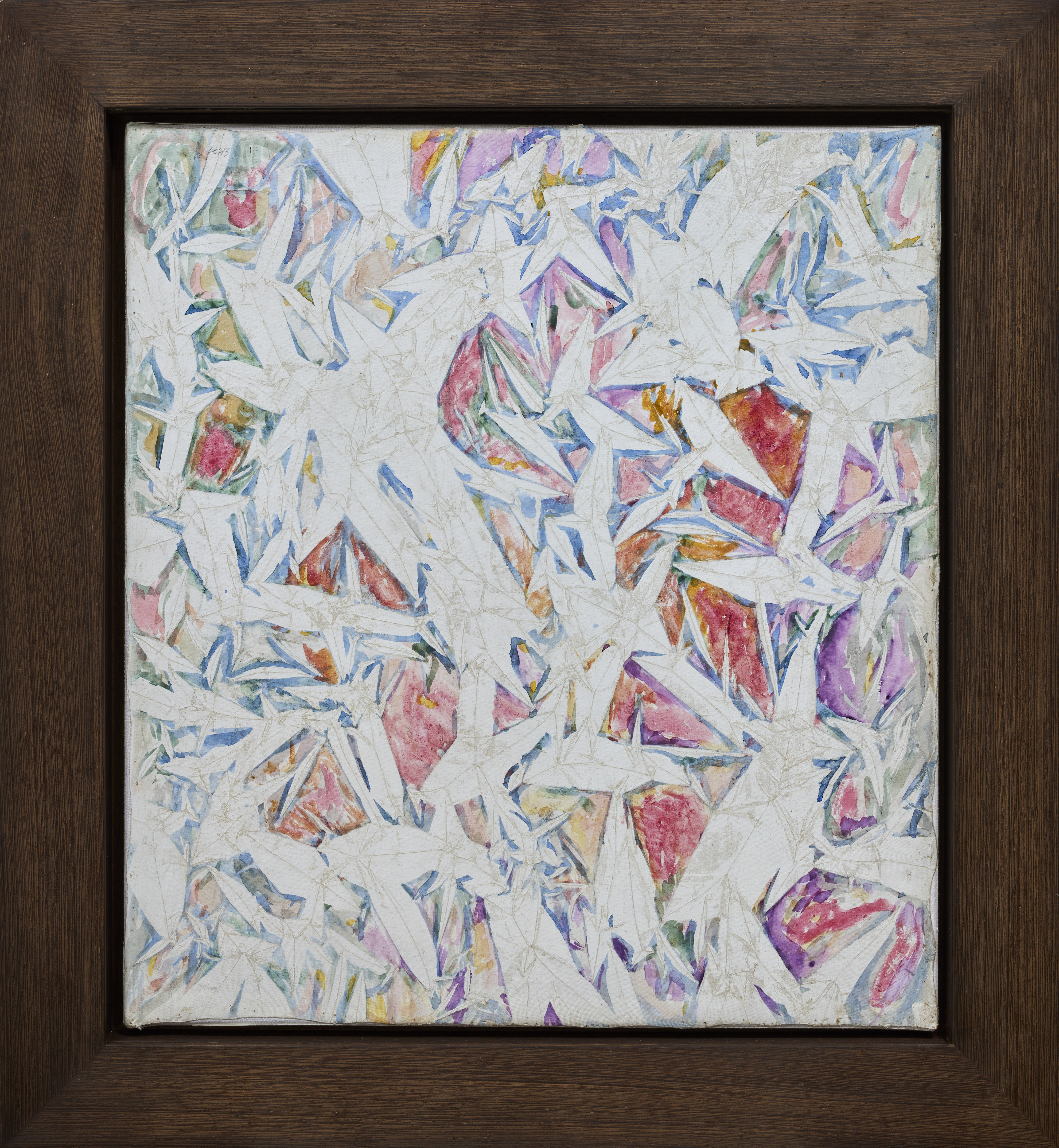Simon HantaïAquarelle
1971
Watercolor on canvas
Monogrammed and dated on the bottom right
19.69 x 17.72 in ( 50 x 45 cm )ZoomInquiry - Aquarelle, 1971
Certificat
Provenance
Private Collection
Erdesz & Maklary Fine Arts Gallery auction, Budapest
Kálmán Makláry Fine Arts, Budapest
Private Collection, France
Sotheby's auction, Paris
Literature
Á. Berecz, Simon Hantaï : Volume 2 : 1960 - 2001, éd.Kalman Maklary Fine Arts, 2013, p. 242
Artwork's description
This work is part of Aquarelles series presented by Jean Fournier Gallery in Paris in 1971. This series employs the folding technique, where the canvas is first treated with a whitewash, then crumpled and folded.
The visible parts are painted with multiple colours. When unfolded, the reserved white areas are revealed. His judicious use of watercolour gives an impression of lightness and fluidity, capturing the very essence of water and nature. Often created in Tondo format, reduced to the foveal task of the eye, this format examines up close the phenomena of convergence and diffraction in the folds. They appear as close, systematic examinations of unfolding and branching generated at these junction points, multiplying the optical center of the painting and a myriad of signs.
The artist believes that the works should live and endure the assaults of time and light without any special protection or frame. He even went so far as to bury some of his works in his garden before retrieving and exhibiting them as they were, stained with dust and organic debris.
Simon Hantaï's Aquarelles series portrays a poetic sensitivity and artistic mastery, where each work takes viewers on a unique emotional journey.
Artist's biography
Simon Hantaï, a prominent figure in gestural abstraction and pictorial folding, is an essential reference in the 20th-century art landscape. Born in 1922 in Bia, Hungary, his artistic journey was shaped by a relentless quest for new forms of expression, influenced by his studies at the Budapest School of Fine Arts and his subsequent move to Paris in 1948.
In the French capital, Hantaï immersed himself in the vibrant artistic scene of the time, drawing inspiration from the Surrealists and renowned gestural artists. In December 1952, on the cusp of his 30th birthday, Simon Hantaï anonymously left a painting at André Breton's doorstep with the inscription: "Look into my eyes. I am searching for you. Do not chase me away." Shortly afterward, he discovered that Breton had opened his gallery, l'Étoile scellée, where his work was displayed alongside a print of Marcel Duchamp's female fig leaf.
When Breton inquired about his identity, Hantaï simply replied, "I am the author of the painting I left at your door." This serendipitous encounter sparked a friendship between the two men and propelled Hantaï into the heart of the Parisian Surrealist circle, where he experimented with various techniques such as collage, scratching, and cutting. His explorations led to the creation of striking works, populated by hybrid bodies and strange forms, each element carrying deep, even esoteric significance. However, tensions soon arose between Hantaï and the Surrealist group. In 1954, Hantaï expressed that automatic painting, as practiced by Pollock and the Americans, was the true novelty, unlike the "trompe-l'œil fixation of dream images." Breton and the Surrealists disagreed with this view.
By the time Hantaï respectfully ended his relationship with Breton in a letter dated March 11, 1955, his painting had already taken him far from Surrealism with remarkable decisiveness. The year 1960 marked a pivotal point in Hantaï's career with the introduction of "folding as a method." This innovation, which became emblematic of his work, transcended the limits of traditional painting by giving the canvas a unique sculptural dimension. It involved crumpling the canvas randomly before applying paint only to the accessible parts. The unfolding then revealed unexpected reliefs and hollows, with unpainted areas increasingly taking on an "active" role in the canvases of various series he developed throughout his life.
Through folding, Hantaï allowed chance to guide his creative process, unveiling compositions of striking beauty and unexpected depth. His first series, titled "Mariales and Manteaux de la Vierge," paid homage to representations of the Madonna in majesty, notably Giotto's famous "Maestà di Ognissanti," which Hantaï discovered in Florence in 1948 and whose intense blue-black mantle profoundly influenced his artistic vision.
Over the years, Hantaï applied his method across several emblematic series. The "Catamurons," named after a vacation home in Varengeville-sur-Mer, featured dark compositions set within light squares, creating a striking contrast. The "Panses," initially titled "Maman! Maman! Dits: la Saucisse," in reference to a text by Michaux, demonstrated the artist's humor and subversion, exploring the form of cells while questioning the boundaries between painting and sculpture. The "Études," initiated in 1968, marked a radical turn in his work with all-over folding and monochrome painting applied edge to edge, breaking from the previous folding logic centered on a motif. The "Aquarelles" and the "Blancs" offered more experimental explorations of medium and technique, while the iconic "Tabulas" series played with rhythms and spaces to create a dynamic interplay between full and empty spaces, offering a profound reflection on the materiality of painting.
As Daniel Buren, who met Hantaï in 1961, noted, he folded and painted "blindly," deliberately allowing chance to take its course. "He never knows, after manipulating his folded canvas, what will emerge upon unfolding." It is this unpredictable and fascinating dimension that gives Hantaï's work its uniqueness and beauty.
Simon Hantaï's work has been widely celebrated through significant retrospectives, notably at the Centre Pompidou in 2013 and the Fondation Louis Vuitton in 2022, marking the centenary of his birth. Throughout his life, Simon Hantaï was supported by Jean Fournier and his eponymous gallery. Since 2019, the American gallery Gagosian has represented his estate and organized numerous exhibitions in honor of the painter, notably in Paris, New York, and Rome.
